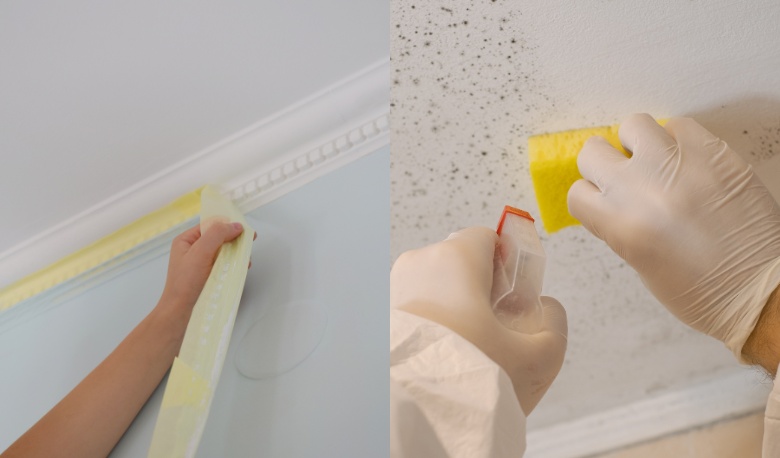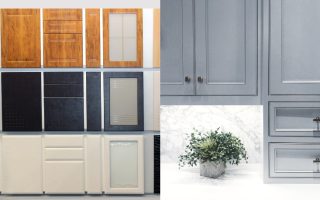Tired of outdated or damaged paint on your kitchen or bathroom cabinets? Removing paint is a great way to give them a fresh start before refinishing or restaining. While it may seem like a daunting task, the right methods and patience can yield beautiful results. This comprehensive guide will walk you through various paint removal techniques, safety precautions, and the entire process from start to finish.
Identifying the Type of Paint
Before you begin, let’s figure out the type of paint you’re working with:
- Latex paint: This water-based paint is common on modern cabinetry and is generally easier to remove than oil-based paints.
- Oil-based paint: Popular in the past, oil-based paint tends to be more durable and often requires a stronger approach for removal.
- Lead-based paint: If your cabinets are from before 1978, there’s a chance of lead-based paint. Contact a professional for safe removal due to toxicity.
Tools and Supplies You’ll Need
Gather these essential items before starting your project:
- Safety gear:
- Gloves
- Safety goggles
- Respirator mask
- Long sleeves and pants.
- Drop cloths or plastic sheeting
- Painter’s tape
- Putty knife or paint scraper
- Sandpaper (various grits from coarse to fine)
- Sanding block
- Cleaning supplies
Choosing the Right Paint Removal Method
Selecting the most effective paint removal method depends on the type of paint you’re dealing with, the intricacy of your cabinets, and the scale of your project. Consider these options:
Heat Gun and Scraper
- Ideal for: This method often works well for latex paint, paint that’s already peeling, and smaller surfaces or detail work. It’s a relatively environmentally-friendly option, as it doesn’t involve harsh chemicals.
- Process: Work in small sections at a time. Hold the heat gun a few inches away from the paint, moving it continuously to avoid scorching the wood. Once you see the paint soften and bubble, immediately use your putty knife or scraper to gently remove the loosened paint.
Chemical Stripper
- Ideal for: Chemical strippers offer a powerful solution for stubborn paint, multiple layers, or intricately carved or molded cabinet faces. Opt for this method if you’re dealing with tough oil-based paints.
- Process: Always prioritize safety when using paint strippers. Choose a well-ventilated area and wear protective gear. Carefully read the manufacturer’s instructions. Apply a generous layer of the stripper, allow it to sit for the specified dwell time, and then scrape away the softened paint. Follow manufacturer guidelines for neutralizing and cleaning the surface after stripping.
Sanding
- Ideal for: Sanding is an effective option for removing thin layers of paint or creating a beautifully smooth surface before applying a new finish. However, sanding alone is usually not enough to remove thicker layers or very stubborn paint.
- Process: Start with a coarse-grit sandpaper (around 80-grit) to tackle tougher areas and gradually progress to finer grits (up to 220-grit) to achieve a smooth, even surface. Always sand in the direction of the wood grain to avoid damaging the wood. For large projects, consider using an orbital sander to save time and effort on flat surfaces.
Step-by-Step Guide to Remove Paint from Cabinets
Removing the old finish before starting your project is crucial for achieving beautiful, long-lasting results on your cabinets. Here’s a detailed guide:
1. Preparation
- Disassembly: Begin by carefully removing cabinet doors and drawers. This provides easier access to all surfaces and protects the interior of your cabinets. Take photos or label each piece for easy reassembly.
- Hardware Removal: Remove hinges, handles, knobs, and any other hardware. Store them safely in a labeled container to avoid losing any parts.
- Workspace Setup: Choose a well-ventilated area, ideally outdoors or in a garage. Protect the surrounding floor and surfaces with drop cloths or plastic sheeting.
- Safety First: Never compromise on safety! Wear chemical-resistant gloves, safety goggles, a respirator mask, long sleeves, and pants for full protection.
2. Initial Paint Removal
-
Heat Gun Method:
Start by applying heat to a small section with your heat gun, holding it a few inches away. Once the paint softens and wrinkles, use a putty knife or paint scraper to gently peel it away. Work in small sections, reheating as needed. This method is ideal for latex paint or small areas.
-
Chemical Stripper:
If your cabinets have stubborn paint or multiple layers, opt for a chemical paint stripper. Choose a product suitable for your paint type and follow the manufacturer’s instructions carefully. Apply the stripper liberally with a brush, allow it to dwell for the recommended time, and then scrape away the softened paint.
-
Sanding:
Use coarse-grit sandpaper (around 80-grit) to remove any lingering paint after using the heat gun or chemical stripper. Always sand in the direction of the wood grain.
3. Cleaning and Neutralizing (for chemical strippers only)
- Follow Instructions: Strictly adhere to the manufacturer’s recommendations for cleaning and neutralizing the surface after stripping. This step is essential to remove residues and prepare the wood for the next stage.
- Use Appropriate Cleaners: Often, water and mild detergent are sufficient. However, for tougher residues, you may need denatured alcohol or mineral spirits.
4. Sanding
- Start Coarse, Finish Fine: After the initial paint removal, start with coarse sandpaper (80-120 grit) to remove any remaining stubborn bits. Gradually work your way up to finer grits (150-220 grit) to create a completely smooth, even surface ready for your new finish.
- Sanding Tools: Use a sanding block for flat surfaces and finer sanding sponges for any contours or details. An orbital sander can be helpful for large, flat areas on cabinet doors.
5. Final Cleaning
- Tack Cloth: Meticulously wipe down all surfaces with a tack cloth to remove every last speck of dust and debris.
- Wash and Dry: Give your cabinets a final clean with soapy water and a sponge. Let them dry completely before applying any new primer, paint, or stain.
Safety Considerations
Your safety should be the top priority throughout the paint removal process. Take these precautions seriously:
-
Protective Gear is Essential: Always protect yourself from harmful chemicals, dust, and potential fumes. Wear chemical-resistant gloves, safety goggles, a respirator mask, long sleeves, and pants. Even when using milder stripping methods, gloves and eye protection are a must.
-
Lead Paint Hazards Homes built before 1978 may have lead-based paint, which is highly toxic, especially when disturbed by sanding or scraping. If your cabinets are older, use a lead paint test kit or contact a professional for testing and safe removal procedures. Never take risks with lead paint.
-
Ventilation is Critical: Whether you’re using a heat gun, chemical strippers, or even just sanding, proper ventilation is a must. Work outdoors if possible. If working indoors, open all windows and doors, and use fans to circulate air and remove fumes. If you’re using strong chemicals, wear a respirator even with good ventilation.
-
Safe Disposal: Paint strippers and the paint waste they remove are often considered hazardous materials. Research and follow your local regulations for safe disposal methods. Never pour leftover chemicals or contaminated liquids down the drain
Remember: Safety should never be an afterthought. Prioritize protecting your health and well-being throughout the entire project.
Additional Tips
- Label cabinet doors and drawers for easy reassembly.
- Take breaks and work in stages, especially for larger projects.
- Consider professional paint removal services for heavily painted or ornate cabinets.
- Research safe disposal of paint and chemical stripper waste in your area.
FAQs
Q: Is it always necessary to remove all the paint before refinishing cabinets?
A: It’s highly recommended. While you might be tempted to simply paint over old paint, this often leads to uneven surfaces, peeling, and unsatisfactory results. Taking the time to fully remove old paint ensures a professional-looking finish for your updated cabinets.
Q: Are there eco-friendly paint removal options?
A: Yes! Look for citrus-based or soy-based paint strippers that are less harsh than traditional solvent-based strippers. Always check the label and prioritize ventilation, even when using these products.
Q: Can I remove paint from cabinet hardware?
A: Absolutely! You can often reuse old hardware and give it a new look. Follow similar paint removal processes, being mindful of any intricate details. Chemical strippers can work well for hardware, but ensure the material is compatible.
Q: What if I still can’t identify the type of paint on my cabinets?
A: A simple test can help. Apply a small amount of denatured alcohol to an inconspicuous area of the paint. If the paint softens, it’s likely latex-based. If it doesn’t react, it’s probably oil-based.
Conclusion
Stripping paint from your cabinets requires some effort, but the results of a beautifully revitalized kitchen or bathroom are incredibly rewarding. Remember to prioritize safety, follow the process carefully, and enjoy the transformation of your cabinets!




